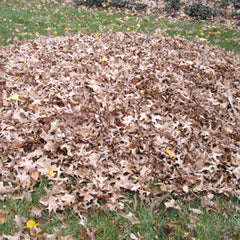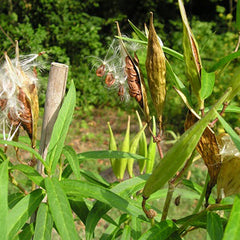It looks like the transition to fall is fully arrived, with several over night temperatures well below freezing in the forecast. That's okay, it is actually quite helpful for perennial plants, which need to go into deep dormancy before really cold weather starts.
So, what does this shift to cooler temperatures mean for your garden chores? Here is a quick look at some of the ways gardeners can ensure plants are tucked in and ready for another season, and get a jump on next year:
- Water perennials / trees / shrubs regularly until the ground starts to be frozen. This is particularly true of recently planted (last three years) trees and shrubs and all evergreens. Fall watering should be deep and regular (about once per week). The reason for the fall waterings is to reduce desiccation caused by the drying winds of winter, and also to ensure roots are well hydrated as plants transfer sugars from the leaves down to the roots ahead of winter.
Lack of moisture is the main reason evergreen plants "brown-out" during winter - a situation that can only be buffered against before winter starts.
- Leave perennials standing (do not cut back), but do thoroughly clean up dropped leaves from any disease or pest prone plants such as lilies (lily beetle), milkweed (aphids), peonies (mildew), rudbeckias (aphids), apples (fungal diseases; insects in fruit). The reason is that stems are left is to help catch blowing leaves and snow for winter, and also to avoid any late season re-growth which is more sensitive to winter kill.
 - Burlap your trees and shrubs. Such an easy way to improve winter conditions for evergreens as well as fruit trees, gingko and any late summer or fall planted tree or shrub. Burlap protects plants from damaging winter winds and buffers against damage from winter sun or warm spells. The trick to burlap is to use poles/posts, creating a simple frame about 6" away from the branches; always avoid wrapping the burlap directly on the tree / shrub. Now is a fine time to start adding the burlap (available in several sizes at Sage). In most cases the burlap does not have to extend to all sides of the tree/shrub - just the south, south west and north west (windward) sides. Exceptions to this rule would be where a plant is already damaged by winter, or if buildings or other structures direct wind towards an exposed side of the tree/shrub.
- Burlap your trees and shrubs. Such an easy way to improve winter conditions for evergreens as well as fruit trees, gingko and any late summer or fall planted tree or shrub. Burlap protects plants from damaging winter winds and buffers against damage from winter sun or warm spells. The trick to burlap is to use poles/posts, creating a simple frame about 6" away from the branches; always avoid wrapping the burlap directly on the tree / shrub. Now is a fine time to start adding the burlap (available in several sizes at Sage). In most cases the burlap does not have to extend to all sides of the tree/shrub - just the south, south west and north west (windward) sides. Exceptions to this rule would be where a plant is already damaged by winter, or if buildings or other structures direct wind towards an exposed side of the tree/shrub.
 - Mulch with loose leaves. One of the biggest unknowns in our region is the amount and timing of snow cover. We have seen extremes in recent winters, from massive piles of snow to complete melts in mid-winter. Fall, winter and early spring fluctuations in temperature and snow cover are the biggest peril to perennials... not the absolute lowest temperature. With predictions for a strong El Nino this winter, much better to have things covered up in mid to late fall, to protect against lack of snow cover. The ideal mulch is dry leaves full of different types, and piled about 6" over perennial beds. These leaves can be chopped-up next season using the lawn mower and become beneficial leaf litter, which does wonders for soil building. Or the leaves can be left in place to become a weed barrier and moisture retainer layer next spring.
- Mulch with loose leaves. One of the biggest unknowns in our region is the amount and timing of snow cover. We have seen extremes in recent winters, from massive piles of snow to complete melts in mid-winter. Fall, winter and early spring fluctuations in temperature and snow cover are the biggest peril to perennials... not the absolute lowest temperature. With predictions for a strong El Nino this winter, much better to have things covered up in mid to late fall, to protect against lack of snow cover. The ideal mulch is dry leaves full of different types, and piled about 6" over perennial beds. These leaves can be chopped-up next season using the lawn mower and become beneficial leaf litter, which does wonders for soil building. Or the leaves can be left in place to become a weed barrier and moisture retainer layer next spring.
- Plant bulbs. With temperatures really cooling down both day time and over night, it is definitely planting season for garlic and ornamental bulbs. We recommend mulching garlic with loose leaves, to avoid shoot emergence before winter (one of the few common problems when growing garlic in our area). Most bulbs are simply planted pointy side up, about 4" below the soil with bonemeal added at time of planting... super easy!
We do have some great colours left in the certified organic flower bulbs, as well as seed garlic still available in store (some varieties now sold out for the year).
- Weed. It is so much easier to get weeds out now compared to hectic spring. Spending a little time now will definitely pay forward! Corn Gluten Meal is the one herbicide product that is fall-friendly, in fact now is an ideal time to apply. It is most often used in lawns, but the pre-emergent herbicide effect is also effective in perennial beds where weed seeds have fallen (it prevents new seedlings from establishing, but does not kill established weeds). The only consideration is that this is a non-selective herbicide, so if you plan to germinate seeds in the bed Corn Gluten is not an option. Sage Garden has a limited amount of Amaizeingly Green Corn Gluten Weed and Feed remaining in stock for this season.
 - Save Seeds. Some perennial plants produce viable seeds that can be saved, shared, or spread in new locations in your garden. Saving and germinating your own home-grown seeds is a cost effective way to establish large patches of perennials such as Milkweed, Echinacea (not the fancy types - these do not re-grow well from seed), Dianthus, Helenium, Rudbeckia, Alliums, Agastache and many more. The best way to grow these is to harvest then plant outdoors, in fall, in a sheltered area where you can keep track of them and transplant next spring. It is often more difficult to attempt to germinate these indoors.
- Save Seeds. Some perennial plants produce viable seeds that can be saved, shared, or spread in new locations in your garden. Saving and germinating your own home-grown seeds is a cost effective way to establish large patches of perennials such as Milkweed, Echinacea (not the fancy types - these do not re-grow well from seed), Dianthus, Helenium, Rudbeckia, Alliums, Agastache and many more. The best way to grow these is to harvest then plant outdoors, in fall, in a sheltered area where you can keep track of them and transplant next spring. It is often more difficult to attempt to germinate these indoors.
If you are interested in more information of saving heirloom and open pollinated seeds, Marilyn Firth is hosting a workshop at Sage on Thursday, October 2, 2015 at 7 pm (pre-registration is required; click here to register or see details)
Good luck preparing your gardens for winter!
Dave Hanson has 20+ years experience helping local gardeners find success. He has co-developed Manitoba's only all-natural full service garden centre and had the opportunity to assist thousands of gardeners along the way. Dave has also been very active as a workshop presenter, speaker and media contributor for print and broadcast, including as the CBC Radio gardening columnist for the last 6 years. Dave brings passion, broad experience and a personal interest in getting to the heart of your gardening questions!







